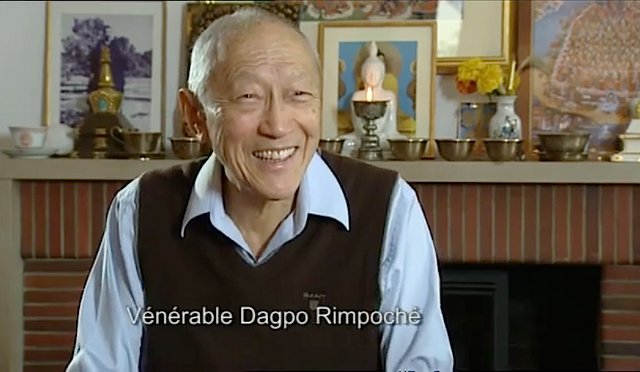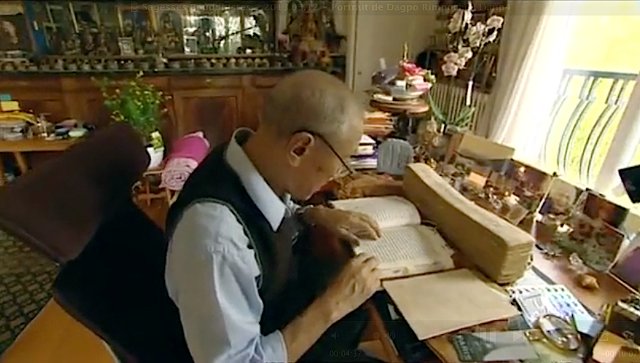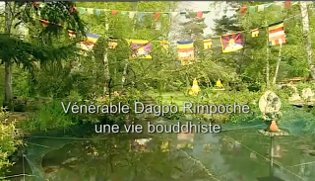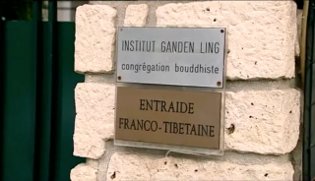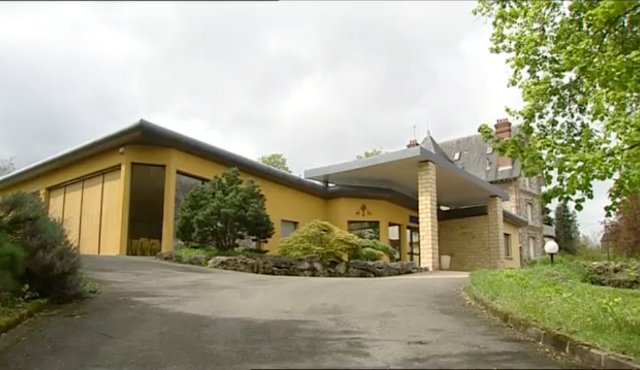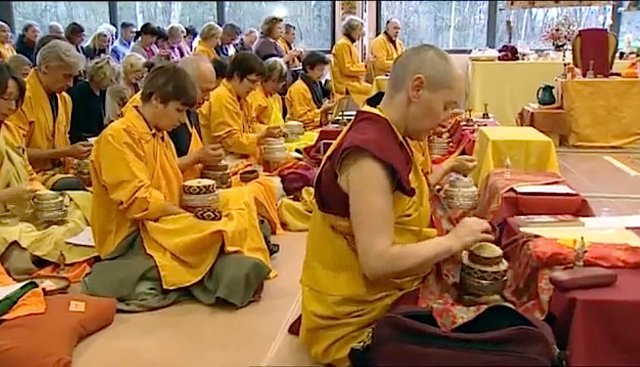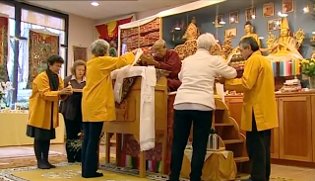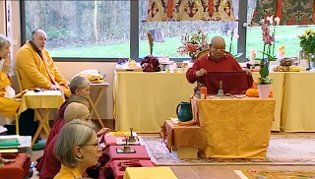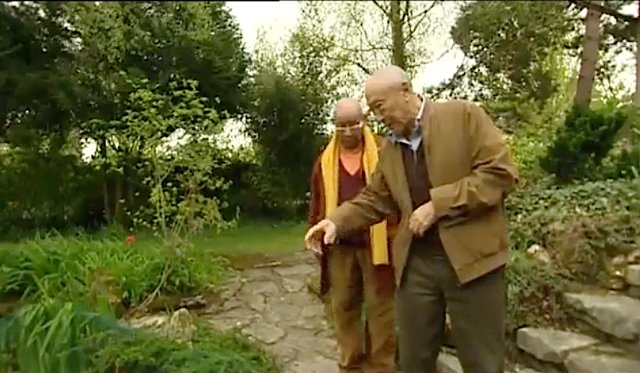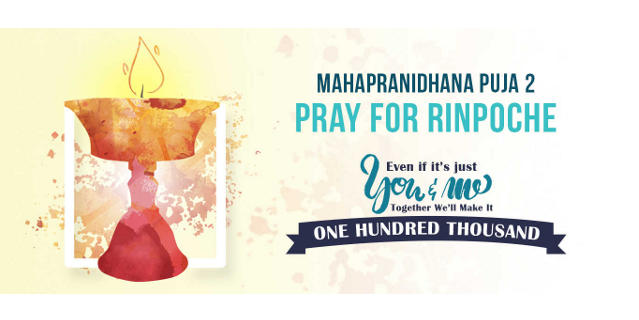
Question & Answer with Ven. Dagpo Rinpoche on Indonesia
Ganden Ling, France, 6 November 2011
Translated from Tibetan into English by Rosemary Patton
Summarized by Candri Kamesvari based on the advice from Ven. Bhadra Ruci
As part of the materials for the preparation of the
25th Anniversary Rinpoche coming to Indonesia
(1989 – 2013)
Q: If out of the blue, suddenly we ask Rinpoche about Indonesia, what does Rinpoche remember or recall about Indonesia? Any specific event? Any spesific person? Any specific memories? If out of the blue, suddenly, like right now.
Ans: One person stands out is the old Laoshi. He is someone very special. Stricly speaking not really a pure buddhist, but he had a very calm personality, very peaceful, someone very much at peace, and sometimes the way he spoke reminded Rinpoche of Kyabje Trijang Dorje Chang. Also because he had a natural ellegance, which is Kyabje Rinpoche also had. A very calm and peaceful person. That’s the most, the strongest, of all the people he met, is the one impressed him the most.
Another person with a different impression is Ashin Jinarakkhita. He was very easy to contact, very pleasant to be with, very friendly. We met at the airport. Before, he gave us the air tickets to go to Palembang. He had a very easy and natural relationship with people. And his physical appearance gave Rinpoche the mental image of a chinese monk in a traditional society, with the long beard and everything.
Another person is Bhante Giri. He is someone very firm, very stable, very true to himself, in the sense that he knew what he believed in. He didn’t waver from that. Rinpoche and Bhante Giri had a very good contact, not very frequent, but a good one.
So, those are the people that struck Rinpoche the most.
Q: After all these years, Rinpoche first came in 1989, now is 2011, so it is more than twenty years, those are really the people who impress him the most?
Ans: Yeah, you asked who are the ones who stood out. Well, those are really the ones who stood out.
Q: Is that it?
Ans: Also maybe because they are older than Rinpoche, have many years of experience, they have been monks for so long, so that makes them carry more weight. They also had a widespread activities.
Bhante Jinarakkhita was the first biksu of Indonesia in the new recent and contemporary time. He did a lot for buddhism in Indonesia. Laoshi has his own tradition and he helped a lot of people, he had many many faithful people follow him and so he helped a lot of people. Bhante Giri followed his own way, had a nice temple and so on, he did a lot also for buddhism in Indonesia in his own way. These are real practitioners.
The first visit always strikes you or remain in your memory clearly, because it is the first, the beginning of something, that’s when we arrived in Bali. The younger Laoshi was there, at that time he wasn’t a Laoshi yet. His spiritual father, the older Laoshi, sent him to greet Rinpoche. It was something completely new to Rinpoche, something different.
Another important person is Dr. Rahman. He was very true to himself, very stable. He was trustworthy. He was someone who knew what he wanted, he knew what he had to do, extremely kind, a real practitioner as well. It’s very sad to lose him so early on. It’s a dissapointment. He was younger than Rinpoche. We had no idea because he was so discreet about himself that he was so sick. If we had known, when we found out it was too late. If we had known earlier, we would have made sure that he would get a proper medical treatment, but when we found out it was too late.
Generally speaking, as far as the overall picture, the early years everything was slow going. It took very long time for things to start moving, for there to be more and more people interested. It was a very gradual progess up to a certain point. And then there was quite a much more blossoming and progress with Suhu. With him becoming a monk, going to India, study there, and then creating the center in Bandung, from there it was almost quite like an explosion. Things really move. That is we can say a very important event as far as Rinpoche can see regarding buddhism in Indonesia.
We can say also the fact of the radical change in the political situation in Indonesia, becoming much more democratic, that also favors the increase of people to be interested in buddhism perhaps. Because at the beginning, one time for example, in one lecture Rinpoche was giving, he started to say that there was poor people everywhere, including in this country, some people don’t have enough to eat and things like that, we were not allowed to say that. Because it sounded like a criticism to the government, so it was not translated into Indonesian that part. Now, that sort of thing no longer a problem, you can say I believe what you want, with the change of the government.
It happened more than once, and it was in the early days. Because there were people from the government attending the teaching to check if it was alright. There was some kind of surveillance I believe.
Before Suhu come and started doing what he did in Indonesia, it was not much. There was not as many people. For example, the same thing happen there happen everywhere. There can be some people come for one or two years and seem very interested but then they dissapear. We lose them. It happens here, but when there was only a few people, not so many people, so that things count.
Q: What are the thoughts underlie before coming to Indonesia?
Ans: Obviously it was because of Lan. She explained the possibility of Rinpoche going there, because of her contacts and everything. She knew Rinpoche’s story and she was very much wanted Rinpoche to come and she invited him. Of course she asked the elder Laoshi whether it was a good idea, whether it would be useful or not. And then he did say “it would be and it was a good idea.”
The elder Laoshi talked about Indonesia being useful for Rinpoche to come to Indonesia, but he also mentioned Malaysia. Even though we have no thought and no particular connection we knew of at Malaysia at the time. It took a couple of years before the thing in Malaysia happen. Rinpoche thought, “Oh, well, why not? Maybe it will be useful. There is only one thing to find out, that is to go.” He hasn’t taught in the East except in India to his Tibetan disciples in Dagpo Dratsang in Meinpad. Of course he was teaching in differrent parts of Europe but not in that part of the region at that time.
Q: What keeps Rinpoche coming and returning to Indonesia?
Ans: Rinpoche started something. Of course he was invited to come again and he accepted. Sometimes he went twice a year actually. For several years he actually went twice a year. The ones inviting Rinpoche to come were Lan and the elder Laoshi before he passed away. And then the younger Laoshi Willy Sim took over and carry on from the elder Laoshi. And also Dr. Rahman, he was the one person who definitely invited Rinpoche to Ujung Pandang. Rinpoche went to Ujung Pandang for quite a few times.
Rs: First we met Dr. Rahman in Java. What’s so funny is what elder Laoshi said about him. He was doing a lot of karate. The elder Laoshi said to slow down on that because he didn’t think it was a good idea to do so much. This I’m not so perfectly clear but I think Dr Rahman would like to have more spiritual activity and become the elder Laoshi’s disciple. But the elder Laoshi said to him that he should wait because his teacher will come later, and it was Rinpoche. The teacher the elder Laoshi talking about was Rinpoche.
Rinpoche remembers that Dr. Rahman knew that Laoshi had trained in certain practices like walking on fire, being able to jump into far distances, a kind of yoga according to the chinese tradition. Lan had seen elder Laoshi doing these. Dr Rahman expressed his interest to follow the same kind of training to be able to do these things. The elder Laoshi said that he could do these things but honestly it wasn’t really worth while and he would be better off pursuing buddhism. Elder Laoshi gave him a copy of biography of Jetsun Milarepa. This happened long time ago and he said to him to wait for his teacher to come, which is Rinpoche.
When Dr. Rahman came from Ujung Pandang to see Rinpoche in Java, probably in Surabaya, then when he invited Rinpoche for the first time to Ujung Pandang, there were other buddhist groups in Ujung Pandang already. But none of them get along at all. They didnt get along at all. Rahman told me when he invited Rinpoche to come to Ujung Pandang, of course he was just one person, he didn’t have organization, he didn’t have the necessary fund to be able to rent a car, and so on, so he actually asked other people. He said everyhting came together. Everyone — many people who didn’t get along — were will willing to help and participate to invite Rinpoche. Everything was just fell together and he was so surprised about how this happened and he was really impressed. He couldn’t believe what he was seeing.
It took more than ten years before things really got moving. It was actually until Suhu went to India, became a monk, study at the monastery, and it took until he came back from India. Rinpoche gave teachings in all sort of different places, sometimes it was just to a small group. Most of the time in the early days nothing was recorded. There was precious teachings going on but nothing was recorded.
Q: Is there any special sign to show anything about Suhu before and after meeting him?
Ans: There was no special sign before and after. He was just a young student. He had a lot of enthusiasm, a lot of earnestness. He said he was determined to listen and to attend all Rinpoche’s teachings after he met Rinpoche.
Suhu was definitely very enthusiastic, very earnest. He was in a hurry, to move ahead with the Dharma, to progress on his practice. He was young and when you’re young you’re always in a hurry.
Once Rinpoche has gone and he kept going because he hope to help Buddhism in Indonesia, help people through Buddhism in Indonesia. Once he has started, he felt it was best to continue because if you just gave up then all the energy and time that you spent already before that would have been a waste of time. So, it’s better to persist, to continue. It’s because he did persist and carry on, the situation has become like it is today. If he had just given up in the middle, then all the time up to then would have been wasted. It’s not as if Rinpoche lacks things to do. He has lots of other things to do, here and other places, but he was hoping still that things will get better and it finally did. Now things are better, well of course you have to carry on too. It’s also because things are good, more people are interested and so on, you have to continue as well.
Then, another reason for going is that, so far as Theravadin Buddhism, it has already been planted in Indonesia. But as far as Tibetan Buddhism was considered, it was very little. If it was, it was not good. Nobody really know the Dharma from the Tibetan Mahayana point of view. So, Rinpoche thought that was another good reason to share the teaching with people. So, there were people supposedly teaching Tibetan Buddhism, but they were not giving a genuine teaching. Because of that, it will not be beneficial to the Indonesian people. Just a lot of initiations and ritual and so on, no real teaching. So, Rinpoche thought he had something to offer that would be helpful to people, to give a proper picture of what Tibetan Buddhism is about also, the real and complete teaching.
Q: What kind of situation happened in Indonesia?
Ans: For example, one Indonesia’s lama, he gave a lot of initiations and all the rituals and ended up in jail at some point. That sort of thing, there is no real teaching. That’s another reason why Rinpoche thought it was important for him to continue to go. Of course if he could have found someone to replace him, to go instead of him, he would have happily to let somebody else go, to carry on. Also because he has many other things to do. He is not getting any younger. Traveling a lot is not very good for your health and so on. Rinpoche said, “Now I haven’t got someone to replace me, to take my place, that’s why I continue to go.”
Q: There is plan to find a replacement?
Ans: Not only in Indonesia, but here also. Sooner or later, when Rinpoche gets older, he won’t be able to continue doing these trips. It’s very tiring. At some time he’ll have to stop doing that.
Q: What is meant by replacement?
Ans: Minimum would be a person, a lama, or a geshe, who is a real practitioner, who knows the Dharma well, who is honest, who has no self-interest, in the sense not just looking for money. Someone who is not looking for power over people. Someone who has a good motivation, who wishes to help others and that alone.
Q: What is Rinpoche’s approach to people in conflict?
Ans: Basically Rinpoche’s principal is that when people are not getting along with somebody else and looks for help he would advise them. He would give advice to try resolve the problem between people in conflict. He would do that, say, up to three times. If they don’t listen to his advice and don’t act on it, then after three times he gives up. Because there is no point. Wasting his time and wasting other people’s time.
Q: What kind of conflicts do people usually come to see Rinpoche for advice?
Ans: All sort of conflicts, between just ordinary people, between couples, between colleagues. There can be disagreement. Out of anger, out of jealousy, out of competitiveness, out of power. Whatever the reasons, whatever kleshas involved, it will create conflict in people. Many many different possibilities and everything is there. I mean, you know, come on. Of course, you know.
Q: I know but we are talking more general in the sense in the course of doing something in Indonesia.
Ans: People come to see Rinpoche for advice all the time. when it’s Indonesia or in here. It’s exactly the same. Same, exactly the same everywhere. People have the same kleshas.
Q: People here and people in Indonesia are exacly the same?
Ans: As far as jealousy, power, anger, of course the same. Everyone has these problems, the same everyone, otherwise in Indonesia everybody would be an Arya or Arhat, which is to say they don’t have kleshas.
Q: Rinpoche has many experience of meeting many kinds of people. Maybe Rinpoche has some comment on the different characteristics of people.
Ans: There are differences of course. For example, both westerners and easterners will get angry, but the way they get angry will be different. In the west, when people get angry, they will immediately let it out, say what they think. They dont hold it back so much. They will immediately express their anger. That has advantages and disadvantages, at least there is some room for discussion. In the East, when they get angry, they don’t necessarily show it, or even admit it to themselves, so it is not necessarily as easy to deal with. Pride of course is there also. In general Eastern people are usually more polite than Westerners.
One thing about Indonesian people is that they are usually more polite, there is more humility, but of course you can’t generalize. And this is of course has been lost in the west, this kind of politeness, and also the way of being humble. Humility has been lost in the west, putting others before you. It used to exist, but it has gone, whereas it could be still found in places like Indonesia. Not always want to put yourself forward. But this is changing of course, including in Indonesia, with the younger people who have received modern education.
Q : What is the problem with modern education?
Ans: It’s a problem with modern western society when young people are no longer taught to respect others, to be polite, just what we called being “well brought up.” Respect for their elders and ethics generally speaking. There is a lack of teaching others ethics. Parents don’t seem to do that anymore for the children. Even if they do, it’s not well enough because the parents are working, both of them, so who’s looking after the kids, you know. Because of the changing of the society, that is the problem here. How it is in Indonesia, we are not really in the position to say.
There are different values. Some things here are considered more important that are not considered important in the East and vice versa. Even there are differences between Europe and North America for that matter, different priorities.
Q: At the beginning Rinpoche mentioned some names that give quite a lot of impression and memory. As far as concerning maintaining Rinpoche’s activities in Indonesia, is there any specific names?
Ans: There are lots of people who are contributing. Each group has a group leader. Everyone is doing the best he or she can, contributing in different ways. That all helps, you know. Because there are these people who carry on when Rinpoche is away, there is still things going on. If everyone stops doing anything when Rinpoche is not there, then obviously there will be no progress. In Rinpoche’s absence, there are people in each group, in each place, that carry on, that continue to contribute to Rinpoche’s activities in Indonesia.
* * * * * *
*Original recording available, dated 6th November 2011
